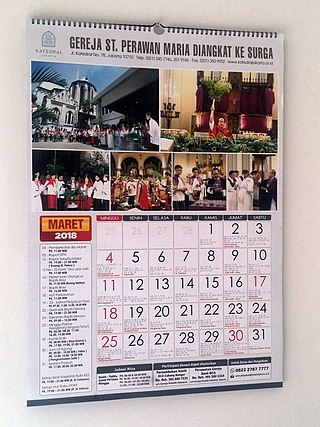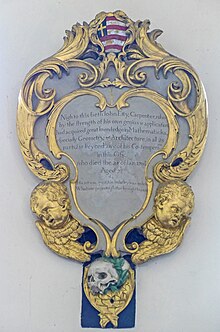
A calendar is a system of organizing days. This is done by giving names to periods of time, typically days, weeks, months and years. A date is the designation of a single and specific day within such a system. A calendar is also a physical record of such a system. A calendar can also mean a list of planned events, such as a court calendar, or a partly or fully chronological list of documents, such as a calendar of wills.

The traditional Chinese calendar is a lunisolar calendar which identifies years, months, and days according to astronomical phenomena. In China, it is defined by the Chinese national standard GB/T 33661–2017, "Calculation and Promulgation of the Chinese Calendar", issued by the Standardization Administration of China on May 12, 2017. Traditional Chinese calendar also known as these five titles: Nongli Calendar, Jiuli Calendar, Laoli Calendar, Zhongli Calendar, Huali Calendar
A calendar date is a reference to a particular day represented within a calendar system. The calendar date allows the specific day to be identified. The number of days between two dates may be calculated. For example, "25 October 2023" is ten days after "15 October 2023". The date of a particular event depends on the observed time zone. For example, the air attack on Pearl Harbor that began at 7:48 a.m. Hawaiian time on 7 December 1941 took place at 3:18 a.m. Japan Standard Time, 8 December in Japan.
The Julian calendar is a solar calendar of 365 days in every year with an additional leap day every fourth year. The Julian calendar is still used in parts of the Eastern Orthodox Church and in parts of Oriental Orthodoxy as well as by the Amazigh people, whereas the Gregorian calendar is used in most parts of the world.
A leap year is a calendar year that contains an additional day added to keep the calendar year synchronized with the astronomical year or seasonal year. Because astronomical events and seasons do not repeat in a whole number of days, calendars that have a constant number of days in each year will unavoidably drift over time with respect to the event that the year is supposed to track, such as seasons. By inserting ("intercalating") an additional day or month into some years, the drift between a civilization's dating system and the physical properties of the Solar System can be corrected.

New Year is the time or day at which a new calendar year begins and the calendar's year count increments by one. Many cultures celebrate the event in some manner. In the Gregorian calendar, the most widely used calendar system today, New Year occurs on January 1. This was also the first day of the year in the original Julian calendar and the Roman calendar.
In chronology and periodization, an epoch or reference epoch is an instant in time chosen as the origin of a particular calendar era. The "epoch" serves as a reference point from which time is measured.
A solar calendar is a calendar whose dates indicate the season or almost equivalently the apparent position of the Sun relative to the stars. The Gregorian calendar, widely accepted as a standard in the world, is an example of a solar calendar. The main other types of calendar are lunar calendar and lunisolar calendar, whose months correspond to cycles of Moon phases. The months of the Gregorian calendar do not correspond to cycles of the Moon phase.

In the Gregorian calendar, New Year's Day is the first day of the year; 1 January. Whilst most solar calendars begin the year regularly at or near the northern winter solstice, cultures that observe a lunisolar or lunar calendar celebrate their Lunar New Year at less fixed points relative to the solar year.

Japanese calendar types have included a range of official and unofficial systems. At present, Japan uses the Gregorian calendar together with year designations stating the year of the reign of the current Emperor. The written form starts with the year, then the month and finally the day, coinciding with the ISO 8601 standard. For example, February 16, 2003, can be written as either 2003年2月16日 or 平成15年2月16日. 年 reads nen and means "year", 月 reads gatsu (がつ) and means "month" and finally 日 (usually) reads nichi and means "day".

The traditional Korean calendar or Dangun calendar is a lunisolar calendar. Dates are calculated from Korea's meridian, and observances and festivals are based in Korean culture.
A calendar era is the period of time elapsed since one epoch of a calendar and, if it exists, before the next one. For example, it is the year 2023 as per the Gregorian calendar, which numbers its years in the Western Christian era.

Old Style (O.S.) and New Style (N.S.) indicate dating systems before and after a calendar change, respectively. Usually, this is the change from the Julian calendar to the Gregorian calendar as enacted in various European countries between 1582 and 1923.

Traditional East Asian age reckoning covers a group of related methods for reckoning human ages practiced in the East Asian cultural sphere, characterized by counting inclusively from 1 at birth and increasing at each New Year instead of each birthday. Ages calculated this way are always 1 or 2 years greater than those calculated solely by birthdays. Historical records from China, Japan, Korea, and Vietnam have usually been based on these methods, whose specific details have varied over time and by place. South Korea officially stopped using the older system on June 28, 2023. Informal use is still widespread in the Republic and People's Republic of China, North and South Korea, Singapore, and the overseas Chinese and Korean diasporas.

The Calendar Act 1750, also known as Chesterfield's Act or the British Calendar Act of 1751, is an Act of the Parliament of Great Britain. Its purpose was for Great Britain and the British Empire to adopt the Gregorian calendar. The Act also rectified other dating anomalies, such as changing the start of the legal year from 25 March to 1 January.
The Gregorian calendar is the calendar used in most parts of the world. It went into effect in October 1582 following the papal bull Inter gravissimas issued by Pope Gregory XIII, which introduced it as a modification of, and replacement for, the Julian calendar. The principal change was to space leap years differently so as to make the average calendar year 365.2425 days long, more closely approximating the 365.2422-day 'tropical' or 'solar' year that is determined by the Earth's revolution around the Sun.
The proleptic Gregorian calendar is produced by extending the Gregorian calendar backward to the dates preceding its official introduction in 1582. In nations that adopted the Gregorian calendar after its official and first introduction, dates occurring in the interim period of 15 October 1582 to the date on which the pertinent nation adopted the Gregorian calendar and abandoned the Julian calendar are sometimes 'Gregorianized' also. For example, the birthday of U.S. President George Washington was originally dated 11 February 1731 because Great Britain, of which he was born a subject, used the Julian calendar and dated the beginning of English years as 25 March. After Great Britain switched to the Gregorian calendar, Washington's birthday was dated 22 February 1732 proleptically, according to the Gregorian calendar applied backward. This remains the modern dating of his birthday.
The regnal years of English and British monarchs are the official regnal years of the monarchs of the Kingdom of England from 1066, the Kingdom of Great Britain from May 1707 to January 1801, and the United Kingdom since January 1801. The regnal calendar continues to be used in many official British government and legal documents of historical interest, notably parliamentary statutes.
This is the calendar for Old Style 1752, a leap year which began on 1 January, and dropped 3–13 September to transition to the Gregorian calendar. Previously, the Old Style calendar in England had begun on 25 March and ended with the following March, on 24 March. Because the Gregorian calendar did not have leap day in 1700, the original 10-day difference in calendars had expanded to an 11-day difference, and to compensate, 2 September was followed by 14 September, as skipping 11 days beyond 3 September. Year 1753, in England followed the full Gregorian calendar. Note, below, the shortened length of September.

The adoption of the Gregorian Calendar was an event in the early modern history of most cultures and societies, marking a change from their traditional dating system to the modern dating system – the Gregorian calendar – that is widely used around the world today. Some states adopted the new calendar from 1582, some did not do so before the early twentieth century, others did so at various dates between. A few still have not, but except for these, the Gregorian calendar is now the world's civil calendar universally, although in many places an old style calendar remains used in religious or traditional contexts During – and for some time after – the change between systems, it has been common to use the terms "Old Style" and "New Style" when giving dates, to indicate which calendar was used to reckon them.












